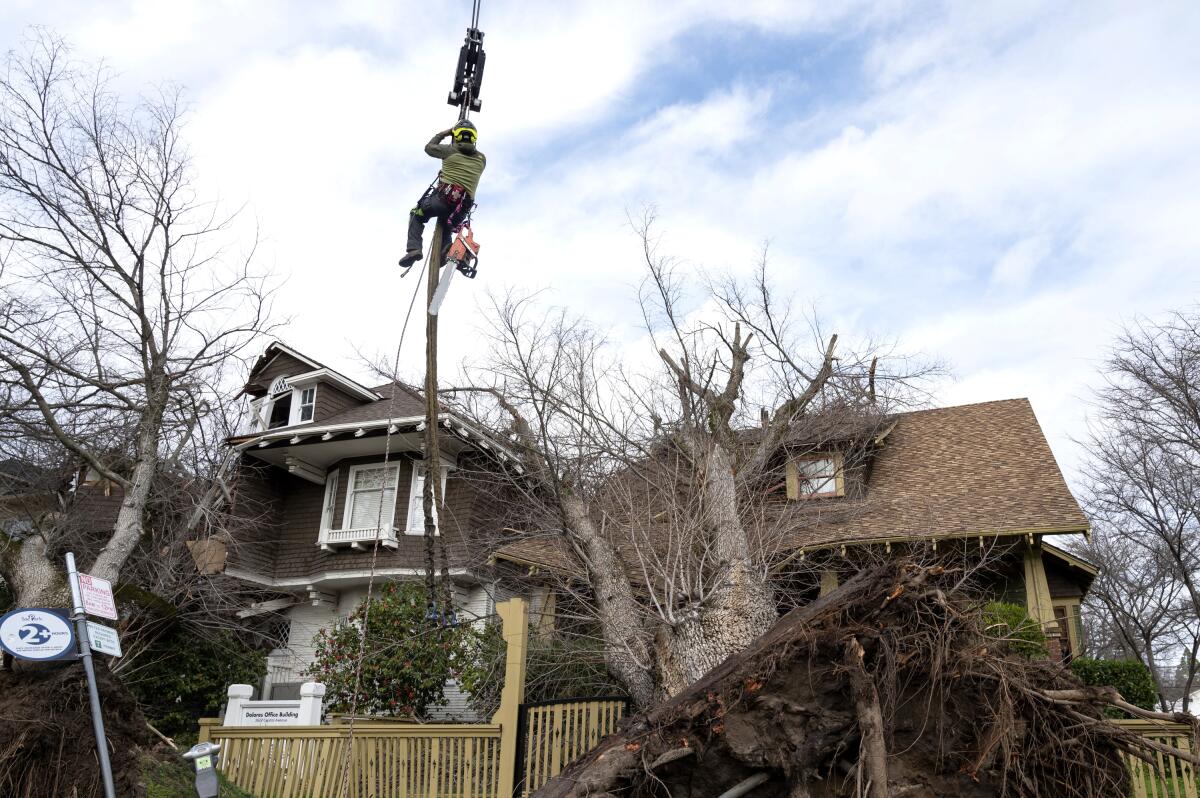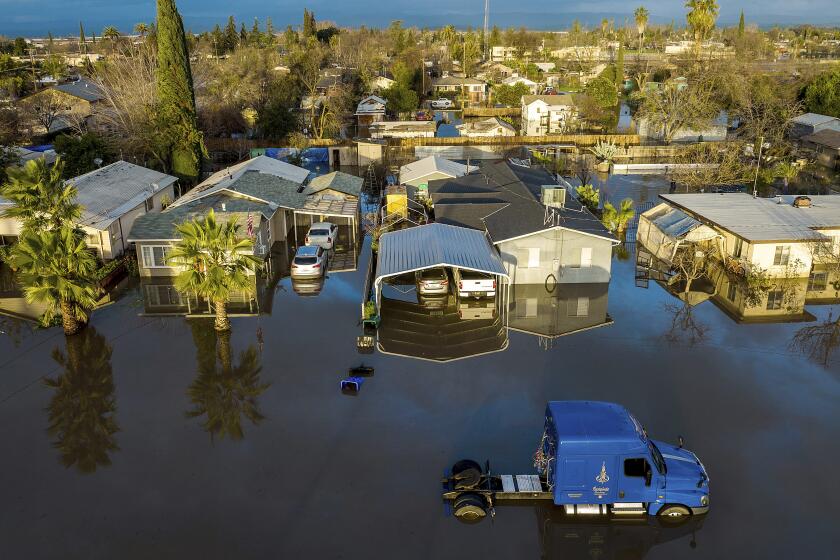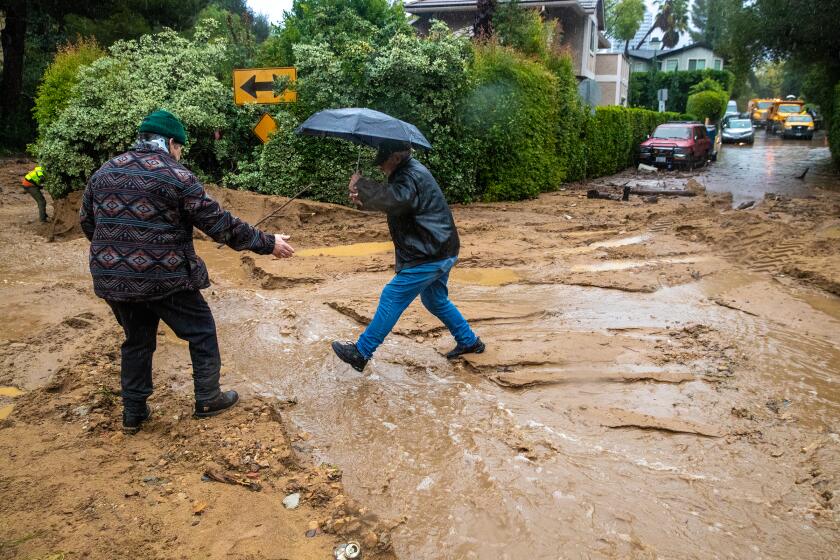A storm-lashed tree damages your home or car — who’s going to pay for that?

- Share via
The winds and rainstorms lashing California this month have sent trees and branches crashing down on houses, garages, cars and, tragically, people.
When a tree trunk or limb damages your property, one of your first questions is likely to be, “Who’s going to pay for this?” Chances are good that you’ll have to pick up at least part of the cost.
There are five key factors at work:
- What was damaged?
- What caused the tree to fall?
- Whose property was the tree on?
- What condition was the tree in?
- What are the terms of your insurance policy?
In some cases, you may have to foot the full bill. In others, though, your net cost could be zero.
Renters across Southern California are facing flood damage caused by the recent series of storms. Here’s how they can protect themselves and their personal property.
Home or auto?
The most likely source of help when a falling tree limb damages something you own is your insurance policy. Damage to a structure on your property — house, garage or shed — would potentially be covered by a homeowners policy. Damage to items inside said house, garage or shed would potentially be covered by a homeowners or renters policy, as would damage to items in a vehicle. Damage to a vehicle could be covered by an auto policy, if it had the right options.
The coverage is merely potential, not certain, because of some of the other factors involved.
First and most important is which sort of weather event uprooted the tree or snapped its limbs.
Your homeowners policy will cover damage caused by trees only if it stemmed from a windstorm, lightning or hail. An earthquake requires a separate policy, as does a flood or a mudslide. Renters’ policies have similar limits.
One notable exception that’s important in California: If the tree is part of a debris flow from an area scorched by a wildfire, you can claim that the “proximate cause” was the fire (which your homeowners policy covers), not the floodwaters (which it doesn’t).
A second crucial question is the condition of the tree. If it was healthy and well-maintained, then the proximate cause of the damage probably was the wind that shook it hard enough to send its limbs flying. That’s considered an event out of your control, and the standard insurance policy will cover it, according to the Insurance Information Institute.
One silver lining for rain-soaked Californians is that the IRS is giving many of them an extra month to file their 2022 tax returns.
You would still have to pay your policy’s deductible, however. If the tree was on someone else’s property, your insurer may seek reimbursement from that person — and possibly refund your deductible as well, the Insurance Information Institute says.
If your claim is paid, your insurance premiums could rise in the future because homeowners insurers base their rates in part on their customers’ claims history. In fact, if you make multiple large claims, you may have trouble finding an insurer willing to cover your home.
If the tree was unhealthy and planted on your property, then your insurer could argue that the proximate cause of the damage was your poor maintenance, not the storm. In that case, you’d have to foot the entire bill. (And even if it was a healthy tree, if its trunk or limbs fell without striking anything, you’d be responsible for the cleanup cost. Your insurer won’t pay for tree removal unless a covered structure is damaged or your driveway is blocked.)
If the unhealthy tree was on someone else’s property, then you should be able to claim reimbursement from that person’s homeowners insurance, Progressive Casualty Insurance Co. says on its website. But it adds, “Keep in mind that negligence can sometimes be difficult to prove. Your case will be stronger if you’ve previously asked the neighbor to remove the decaying tree or sent them a certified letter from a tree professional stating the need for the tree to be removed.”
L.A. County property owners who suffer more than $10,000 in losses may qualify for a property tax reassessment. They may also get a break on penalties for missing the April deadline for paying their property tax bill.
What if my car is plastered by a tree?
The first question here is whether you have “comprehensive” coverage. The state of California requires drivers to have liability coverage; collision and comprehensive insurance, are optional.
For the record:
4:07 p.m. Jan. 17, 2023An earlier version of this story said that California requires drivers to be insured for collisions and liability. The state requires coverage for liability only.
If you do have that coverage, the second question is whether the tree in question was on your property. If so, your auto insurer could deny your claim if the tree wasn’t well-maintained or if its collapse wasn’t caused by winds, hail or lightning.
Assuming that it wasn’t your tree, or at least not a sickly tree in your yard, and you have comprehensive coverage, you’ll still have to pay the deductible. Under California law, though, your auto insurance premiums should not go up after a claim if you’re not principally at fault.
About The Times Utility Journalism Team
This article is from The Times’ Utility Journalism Team. Our mission is to be essential to the lives of Southern Californians by publishing information that solves problems, answers questions and helps with decision making. We serve audiences in and around Los Angeles — including current Times subscribers and diverse communities that haven’t historically had their needs met by our coverage.
How can we be useful to you and your community? Email utility (at) latimes.com or one of our journalists: Jon Healey, Ada Tseng, Jessica Roy and Karen Garcia.
More to Read
Totally Worth It
Be your money's boss! Learn how to make a budget and take control of your finances with this eight-week newsletter course.
You may occasionally receive promotional content from the Los Angeles Times.














